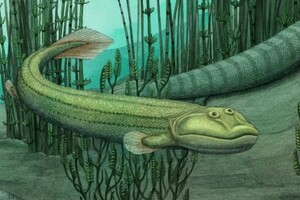This is a clear example of “reverse” evolution.

About 365 million years ago, one group of fish left water in order to start living on land. These creatures were the early quadrupeds, which later gave rise to thousands of species, including amphibians, birds, and humans. But it turned out that not all of these creatures continued to live on land, some of them returned to the water, reports Science Alert.
Researchers found a fossil that shows that at least one of the fish that went out on land, returned to the water way of life. Instead of using its fins to move along the seabed and come ashore, it used them exclusively for swimming.
Also read: Scientists have revealed why deep-sea corals glow in the dark
In 2020, scientists from the University of Chicago re-examined the fossil, which was found back in 2004 in the Arctic. Then the researchers found a fragment of a jaw five centimeters long with sharp teeth. Areas of white scales with a hilly structure were also detected. Scientists assumed they were dealing with an early tetrapod, but they needed to look inside the rock in which the fossils were found.
The researchers used a computed tomography technique that allowed them to pass X-rays through the sample and reveal anything that was hidden from view. As a result, they managed to find a whole swimmer. But the scientists were unable to complete the research because the campus was closed for quarantine due to COVID-19.
As soon as the scientists were able to return to the laboratory, they continued the analysis. They scanned the swimmer again and were able to get a closer look. A complete analysis of the scales, jaw and fin revealed that the researchers were dealing with a new species. It also turned out to be one of the closest relatives of vertebrates with limbs – creatures with fingers and toes.
The creature was named Qikiqtania wakei, a name referring to the region in which the fossil was found. The species name was given in honor of the scientist David Wake.
The scaly fish indicated that it lived underwater. In addition, they found sensory channels that allowed the creature to sense the flow of water around it. The jaws indicated that it was a predator that held its prey with its fangs. But the pectoral fin of Qikiqtania surprised scientists the most, it had a humerus like a human shoulder, but it was distinguished by a peculiar shape.
Early tetrapods had humeral fins with a protruding ridge on the underside and a characteristic set of bulges, to to which the muscles were attached. Such muscles suggest that early tetrapods lived on the bottom of lakes and streams, using their fins or arms to support themselves first on the ground underwater and then on land.
But Qikiqtania's humerus was different , it lacked characteristic crests and processes. But it was thin and resembled the shape of a boomerang, the remaining part of the fin was large and oar-shaped. Such a fin was designed for swimming.
Scientists believe that these features indicate that this ancient fish returned from land to live in water again.
Earlier, scientists conducted a new study fossils that include the brain and nervous system of creatures Stanleycaris hirpex that lived on Earth 500 million years ago. They came to the conclusion that these creatures can change existing ideas about the evolution of insects and arthropods.




